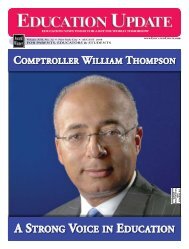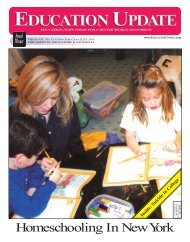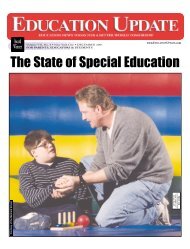Download PDF - Education Update
Download PDF - Education Update
Download PDF - Education Update
Create successful ePaper yourself
Turn your PDF publications into a flip-book with our unique Google optimized e-Paper software.
APRIL 2003 ■ EDUCATION UPDATE ■ COVER STORYSCHOOL5Chancellor Matthew Goldstein at the Helm of CUNYBy JOAN BAUM, Ph.D.On maps of old, dangerous or unknown territorysuspected of harboring sea monsters wasmarked hic sunt dracones. Only those skilledenough to navigate the treacherous waters survived.In June 1999, Benno Schmidt, thenChairman of the Mayor’s Advisory task Forceon CUNY, reported that The City University ofNew York was “An Institution Adrift.” Threemonths later, in the wake of the Schmidt blueprintfor reform, Dr. Matthew Goldstein wasappointed Chancellor. Now, four years later,with Dr. Schmidt having just been namedChairman of the CUNY Board of Trustees,Chancellor Goldstein can state that he has notonly negotiated passage through some roughpolitical and financial seas but that he hasfound secure mooring for the 20 colleges andgraduate and professional schools that make upthe nation’s most diverse public institution ofhigher education. With rigor, commitment, andwide support from all constituencies, and withoutcompromising CUNY’s mission as anurban university, the Chancellor has tightenedadmissions and assessment criteria and turned aloose federation of often competing collegesinto a unified three-tiered system of flagshipprograms that could serve as models for otherpublic universities intent on piloting a similarcourse.The turnaround is quite an accomplishment,considering that barely four years ago CUNYwas said to be listing dangerously: enrollmentand retention were imperiled, experienced facultywere retiring, and the press seemed unrelentingin its criticism. Now ChancellorGoldstein points to the success of initiativesthat have helped CUNY “stay the course.”Enrollments went up 10.5 % and the averageSAT scores of those entering the selective seniorcolleges shot up 80 points. In an addressthis past January at the Harvard Club on “fiscalchallenges and new opportunities” at CUNY,the Chancellor reminded his audience that someyears ago he had warned that “unless CUNYstarted to raise the bridge instead of loweringthe river, our students would never learn how toswim.” He is obviously pleased that “thebridge is going up” and that students as well asfaculty and administration “are much strongerswimmers than we were, much better able tohandle the uncertain tides of a rapidly changingworld.” A new assessment program “turned [theuniversity] inside out,” and the new tier structure,with its commitment to articulationbetween the two- and four-year colleges, aswell as the introduction of an executive compensation/managementperformance system arehelping sustain a new “meritocracy.”Confident about what Chairman Schmidtcalls CUNY’s “revitalization,” the Chancelloris contemplating new ports of call, such asGovernors Island, which he envisions as a sitefor an international think tank that would bringtogether prestigious CUNY faculty and leadingscientists at neighboring institutions to do cutting-edgeresearch on issues critical to the cityand the surrounding region. The Chancelloralso talks about a Journalism School, a Schoolof Professional Studies (in conjunction with theEconomic Development Corporation), moreuniversity-wide interdisciplinary programs,further collaboration with the New York CityDepartment of <strong>Education</strong>, and continuedenhancement up and down the line of “liberallearning.” It’s obvious that the Chancellor hasmore in mind than staying the course — he alsointends to steer into unchartered waters.Instinctively he draws his phrases andimagery not from nautical lore, however, butmathematical statistics, the field in which heearned a B.A. at The City College and a doctorateat the University of Connecticut, and inwhich he has published widely. A former presidentof Baruch College, of the CUNY ResearchFoundation, and of Adelphi University,Chancellor Goldstein talks of “large variance,”data and “new managerial systems.” While hisbackground in both mathematics and highereducation administration would seem to haveprepared him for the fundraising campaignsand academic program reviews he faces continually,he says that heading up CUNY has been“the biggest challenge” he has ever faced.Other large universities don’t have the university’sextraordinary diversity, its vast number oflow-income and immigrant students (“only inAmerica”) and its increasing number of thosewho could have gone on to ivy league schoolsbut who chose CUNY instead, some of whom,perhaps were attracted to the new universitywideHonors College. With 325 participants,out of 2,500 applicants, the Honors College,now in its third year, is expected to grow to1,400-1,600. The Chancellor beams. Other successesripple out for him, the Teacher <strong>Education</strong>programs, now reflected in the over 90% passrate on certification exams, the CUNY-highschools partnerships, and the Teaching Fellows,which originated at CUNY in joint sponsorshipwith High Schools Chancellor Joel Klein. “Noother university system is so closely linked withpublic high schools.”“We’re serious,” the Chancellor says morethan once about the university, which doesn’tmean, of course, that the Chancellor always is.Playful, full of anecdotes (“let me illustrate thatCUNY Chancellor Matthew Goldsteinpoint with a story”) and obviously enjoying hisrole at the helm, a company man, he nonethelessrefers to himself as a “maverick.” He isalso a lover of opera and art and an appreciatorof intellectual quality. He likes “to be aroundvery smart people helping to solve very complexproblems,” and the “extraordinary faculty”at CUNY deliver. He doesn’t just mean theNobelists who make the news, or even theresearch-oriented professors who teach at theGraduate School, where one third of the Ph.Dprograms are ranked nationally. He meansteachers on all the campuses. Despite budgetreductions this year, he has managed to hire450 new full-timers.The hour is late, the day cold and rainy, buthe’s off in a minute to attend a poetry jam inThe Bowery. “Chancellors have to bang heads,”he says, but they also need to listen quietly tonew ideas. Vessels cannot always beat into thewind. Sometimes they reach their destinationsbest by simply yielding to the currents.#STAFFDEVELOPMENT“A must-have toolfor teachers!”Is your child Dyslexicor experiencing school failure?If so, we may be the solution.We strive to help children not only havethe skills needed to learn, but to want to learn.Learn about classroom management,teaching for mastery, and creating positiveexpectations as The First Days of School helpsyou to become an even more effective teacher.OTHER PRODUCTS FROM WHALEY GRADEBOOK CO.• Two- and Three-Line Record Books by Merle J. Whaley (The only Gradebook to befeatured in the book “The First Day of School” pg 139)• “New Teacher Induction” by Annette L. Breaux and Harry K. Wong• “Discipline Without Stress, Punishment, or Rewards” by Marvin Marshall• “The Professor’s Secrets” (Fast Track Writing System) by Bernie GaidoschWHALEYGRADEBOOK CO, INC.2941 B 1 ⁄2 Road • Grand Jct, CO 81503 TEL 970/241-7777 • FAX 970/241-0016EMAIL office@whaleygradebook.com WEBSITE whaleygradebook.comWe take our commitment seriously• Orton Gillingham trained staff• Small classes with individualized attention• Art, music, culinary arts, and computers for arich educationCall 718-625-3502 or contact: Ruth Arberman,Director of The Sterling School299 Pacific Street, Brooklyn, New York 11201Now Accepting Admissions
















